Nikon B600 vs Ricoh WG-60
The Nikon Coolpix B600 and the Ricoh WG-60 are two digital cameras that were revealed to the public, respectively, in January 2019 and October 2018. Both the B600 and the WG-60 are fixed lens compact cameras that are equipped with a 1/2.3-inch sensor. Both cameras offer a resolution of 15.9 megapixels.
Below is an overview of the main specs of the two cameras as a starting point for the comparison.

Check B600 offers at
ebay.com

Check WG-60 offers at
ebay.com
Going beyond this snapshot of core features and characteristics, what are the differences between the Nikon Coolpix B600 and the Ricoh WG-60? Which one should you buy? Read on to find out how these two cameras compare with respect to their body size, their imaging sensors, their shooting features, their input-output connections, and their reception by expert reviewers.
Body comparison
The physical size and weight of the Nikon B600 and the Ricoh WG-60 are illustrated in the side-by-side display below. The two cameras are presented according to their relative size. Three successive views from the front, the top, and the rear are shown. All width, height and depth measures are rounded to the nearest millimeter.
Both cameras are available in two different colors (black, red).
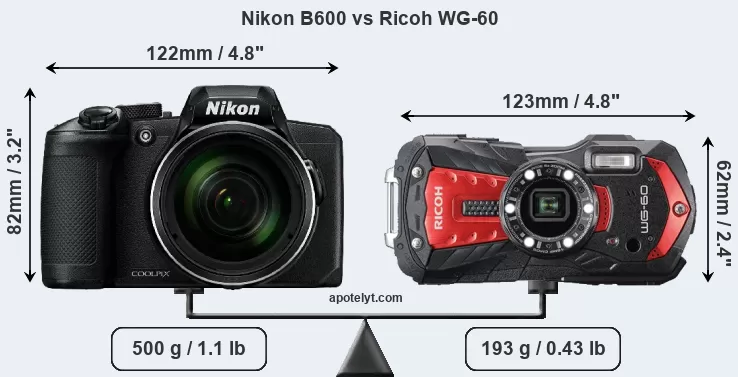
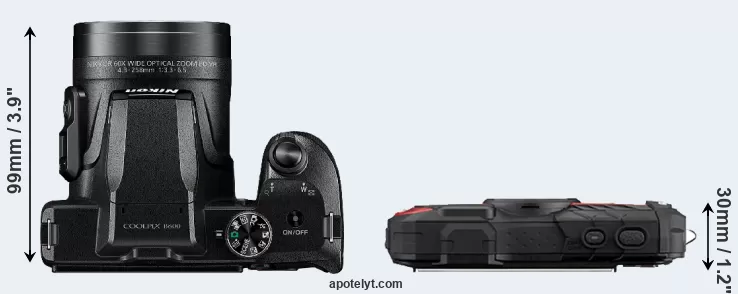
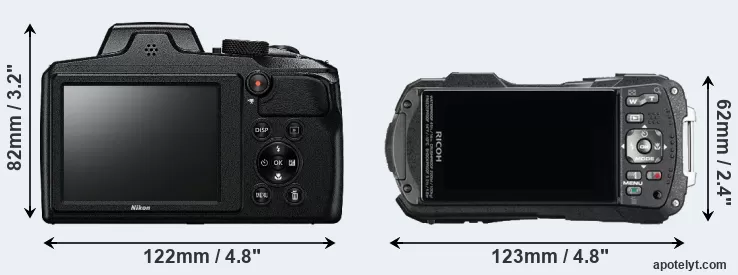
If the front view area (width x height) of the cameras is taken as an aggregate measure of their size, the Ricoh WG-60 is notably smaller (24 percent) than the Nikon B600. Moreover, the WG-60 is substantially lighter (61 percent) than the B600. It is noteworthy in this context that the WG-60 is splash and dust-proof, while the B600 does not feature any corresponding weather-sealing. More than that, the WG-60 is water-proof up to 14m and can, thus, be used for underwater photography.
The table below summarizes the key physical specs of the two cameras alongside a broader set of comparators. If you would like to visualize and compare a different camera combination, you can navigate to the CAM-parator app and make your selection from a broad list of cameras there.

| Camera Model |
Camera Width |
Camera Height |
Camera Depth |
Camera Weight |
Battery Life |
Weather Sealing |
Camera Launch |
Launch Price (USD) |
Street Price |
||
|---|---|---|---|---|---|---|---|---|---|---|---|
| 1. | Nikon B600 | 122 mm | 82 mm | 99 mm | 500 g | 280 | n | Jan 2019 | 349 | ebay.com | |
| 2. | Ricoh WG-60 | 123 mm | 62 mm | 30 mm | 193 g | 300 | Y | Oct 2018 | 279 | ebay.com | |
| 3. | Canon SX520 | 120 mm | 82 mm | 92 mm | 441 g | 210 | n | Jul 2014 | 399 | ebay.com | |
| 4. | Fujifilm XP120 | 110 mm | 71 mm | 28 mm | 203 g | 210 | Y | Jan 2017 | 229 | ebay.com | |
| 5. | Fujifilm XP130 | 110 mm | 71 mm | 28 mm | 207 g | 240 | Y | Jan 2018 | 229 | ebay.com | |
| 6. | Nikon A1000 | 114 mm | 72 mm | 41 mm | 330 g | 250 | n | Jan 2019 | 429 | ebay.com | |
| 7. | Nikon B500 | 114 mm | 78 mm | 95 mm | 541 g | 600 | n | Jan 2016 | 299 | ebay.com | |
| 8. | Nikon L840 | 113 mm | 78 mm | 96 mm | 538 g | 590 | n | Feb 2015 | 299 | ebay.com | |
| 9. | Nikon P900 | 140 mm | 103 mm | 137 mm | 899 g | 360 | n | Mar 2015 | 599 | ebay.com | |
| 10. | Nikon P950 | 140 mm | 110 mm | 150 mm | 1005 g | 290 | n | Jan 2020 | 799 | amazon.com | |
| 11. | Nikon P1000 | 146 mm | 119 mm | 181 mm | 1415 g | 250 | n | Jul 2018 | 999 | amazon.com | |
| 12. | Nikon W300 | 112 mm | 66 mm | 29 mm | 231 g | 280 | Y | May 2017 | 389 | ebay.com | |
| 13. | Panasonic FZ100 | 124 mm | 82 mm | 92 mm | 540 g | 410 | n | Jul 2010 | 499 | ebay.com | |
| 14. | Pentax WG-90 | 123 mm | 62 mm | 30 mm | 194 g | 300 | Y | Nov 2023 | 279 | amazon.com | |
| 15. | Sony WX800 | 102 mm | 58 mm | 36 mm | 233 g | 370 | n | Oct 2018 | 399 | ebay.com | |
| Note: Measurements and pricing do not include easily detachable parts, such as add-on or interchangeable lenses or optional viewfinders. | |||||||||||
The price is, of course, an important factor in any camera decision. The retail prices at the time of the camera’s release place the model in the market relative to other models in the producer’s line-up and the competition. The WG-60 was launched at a somewhat lower price (by 20 percent) than the B600, which makes it more attractive for photographers on a tight budget. Normally, street prices remain initially close to the MSRP, but after a couple of months, the first discounts appear. Later in the product cycle and, in particular, when the replacement model is about to appear, further discounting and stock clearance sales often push the camera price considerably down.
Sensor comparison
The size of the imaging sensor is a crucial determinant of image quality. All other things equal, a large sensor will have larger individual pixel-units that offer better low-light sensitivity, wider dynamic range, and richer color-depth than smaller pixels in a sensor of the same technological generation. Moreover, a large sensor camera will give the photographer more control over depth-of-field in the image and, thus, the ability to better isolate a subject from the background. On the downside, larger sensors tend to be associated with larger, more expensive camera bodies and lenses.
Both cameras under consideration feature a 1/2.3-inch sensor and have a format factor (sometimes also referred to as "crop factor") of 5.6. Within the spectrum of camera sensors, this places the review cameras among the smaller-sensor digicams that favor affordability and compact design. Both cameras feature a native aspect ratio (sensor width to sensor height) of 4:3.
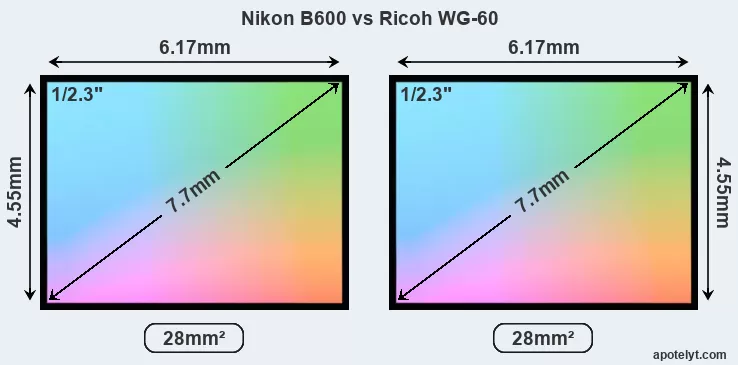
The two cameras under review do not only share the same sensor size, but also offer an identical resolution of 15.9 megapixels. This similarity in sensor specs implies that both the B600 and the WG-60 have the same pixel density, as well as the same pixel size. Moreover, the two cameras were released in close succession, so that their sensors are from the same technological generation. Coming back to sensor resolution, it should be mentioned that neither of the two cameras has an anti-alias filter installed, so they are able to capture all the detail the sensor resolves.
The Nikon Coolpix B600 has a native sensitivity range from ISO 125 to ISO 6400. The Ricoh WG-60 offers exactly the same ISO settings.
Technology-wise, both cameras are equipped with CMOS (Complementary Metal–Oxide–Semiconductor) sensors. Both cameras use a Bayer filter for capturing RGB colors on a square grid of photosensors. This arrangement is found in most digital cameras.
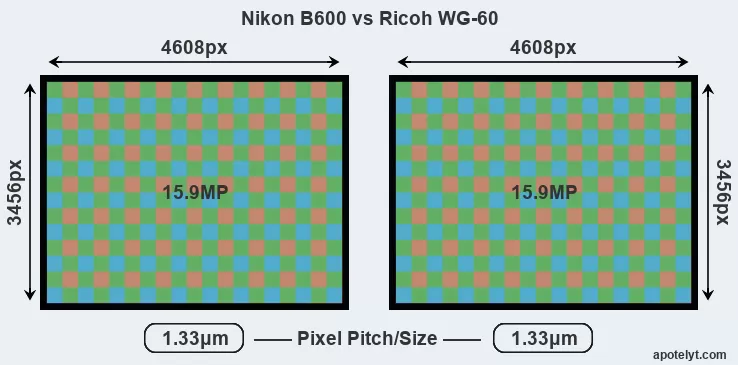
For many cameras, data on sensor performance has been reported by DXO Mark. This service determines an overall sensor rating, as well as sub-scores for low-light sensitivity ("DXO Sports"), dynamic range ("DXO Landscape"), and color depth ("DXO Portrait"). The table below summarizes the physical sensor characteristics and sensor quality findings and compares them across a set of similar cameras.

| Camera Model |
Sensor Class |
Resolution (MP) |
Horiz. Pixels |
Vert. Pixels |
Video Format |
DXO Portrait |
DXO Landscape |
DXO Sports |
DXO Overall |
||
|---|---|---|---|---|---|---|---|---|---|---|---|
| 1. | Nikon B600 | 1/2.3 | 15.9 | 4608 | 3456 | 1080/30p | 20.7 | 12.2 | 1095 | 52 | |
| 2. | Ricoh WG-60 | 1/2.3 | 15.9 | 4608 | 3456 | 1080/60p | 20.6 | 12.2 | 1072 | 51 | |
| 3. | Canon SX520 | 1/2.3 | 15.9 | 4608 | 3456 | 1080/30p | 20.1 | 11.5 | 672 | 46 | |
| 4. | Fujifilm XP120 | 1/2.3 | 15.9 | 4608 | 3456 | 1080/60p | 20.5 | 11.9 | 900 | 49 | |
| 5. | Fujifilm XP130 | 1/2.3 | 15.9 | 4608 | 3456 | 1080/60p | 20.6 | 12.1 | 1000 | 51 | |
| 6. | Nikon A1000 | 1/2.3 | 15.9 | 4608 | 3456 | 4K/30p | 20.7 | 12.2 | 1095 | 52 | |
| 7. | Nikon B500 | 1/2.3 | 15.9 | 4608 | 3456 | 1080/60i | 20.3 | 11.7 | 810 | 48 | |
| 8. | Nikon L840 | 1/2.3 | 15.9 | 4608 | 3456 | 1080/60i | 20.2 | 11.6 | 721 | 47 | |
| 9. | Nikon P900 | 1/2.3 | 15.9 | 4608 | 3456 | 1080/60p | 20.2 | 11.6 | 727 | 47 | |
| 10. | Nikon P950 | 1/2.3 | 15.9 | 4608 | 3456 | 4K/30p | 20.7 | 12.3 | 1189 | 52 | |
| 11. | Nikon P1000 | 1/2.3 | 15.9 | 4608 | 3456 | 4K/30p | 20.6 | 12.1 | 1044 | 51 | |
| 12. | Nikon W300 | 1/2.3 | 15.9 | 4608 | 3456 | 4K/30p | 20.5 | 12.0 | 938 | 50 | |
| 13. | Panasonic FZ100 | 1/2.3 | 14.0 | 4320 | 3240 | 1080/60i | 19.4 | 10.7 | 306 | 39 | |
| 14. | Pentax WG-90 | 1/2.3 | 15.9 | 4608 | 3456 | 1080/60p | 20.9 | 12.8 | 1570 | 54 | |
| 15. | Sony WX800 | 1/2.3 | 18.0 | 4896 | 3672 | 4K/30p | 20.6 | 12.2 | 1070 | 51 | |
| Note: DXO values in italics represent estimates based on sensor size and age. | |||||||||||
Many modern cameras cannot only take still pictures, but also record videos. The two cameras under consideration both have sensors whose read-out speed is fast enough to capture moving pictures, and both provide the same movie specifications (1080/30p).
Feature comparison
Apart from body and sensor, cameras can and do differ across a variety of features. The B600 and the WG-60 are similar in the sense that neither of the two has a viewfinder. The images are, thus, framed using live view on the rear LCD. The following table reports on some other key feature differences and similarities of the Nikon B600, the Ricoh WG-60, and comparable cameras.

| Camera Model |
Viewfinder (Type or 000 dots) |
Control Panel (yes/no) |
LCD Specifications (inch/000 dots) |
LCD Attach- ment |
Touch Screen (yes/no) |
Max Shutter Speed * |
Max Shutter Flaps * |
Built-in Flash (yes/no) |
Built-in Image Stab |
||
|---|---|---|---|---|---|---|---|---|---|---|---|
| 1. | Nikon B600 | none | n | 3.0 / 921 | fixed | n | 1/4000s | 7.4/s | Y | Y | |
| 2. | Ricoh WG-60 | none | n | 2.7 / 230 | fixed | n | 1/4000s | 8.0/s | Y | n | |
| 3. | Canon SX520 | none | n | 3.0 / 461 | fixed | n | 1/2000s | 1.6/s | Y | Y | |
| 4. | Fujifilm XP120 | none | n | 3.0 / 920 | fixed | n | 1/2000s | 10.0/s | Y | Y | |
| 5. | Fujifilm XP130 | none | n | 3.0 / 920 | fixed | n | 1/2000s | 10.0/s | Y | Y | |
| 6. | Nikon A1000 | 1166 | n | 3.0 / 1036 | tilting | Y | 1/4000s | 7.0/s | Y | Y | |
| 7. | Nikon B500 | none | n | 3.0 / 921 | tilting | n | 1/4000s | 7.4/s | Y | Y | |
| 8. | Nikon L840 | none | n | 3.0 / 921 | tilting | n | 1/4000s | 7.4/s | Y | Y | |
| 9. | Nikon P900 | 921 | n | 3.0 / 921 | swivel | n | 1/4000s | 7.0/s | Y | Y | |
| 10. | Nikon P950 | 2359 | n | 3.2 / 921 | swivel | n | 1/4000s | 7.0/s | Y | Y | |
| 11. | Nikon P1000 | 2359 | n | 3.2 / 921 | swivel | n | 1/4000s | 7.0/s | Y | Y | |
| 12. | Nikon W300 | none | n | 3.0 / 921 | fixed | n | 1/4000s | 7.0/s | Y | Y | |
| 13. | Panasonic FZ100 | 202 | n | 3.0 / 460 | swivel | n | 1/2000s | 11.0/s | Y | Y | |
| 14. | Pentax WG-90 | none | n | 2.7 / 230 | fixed | n | 1/4000s | 8.0/s | Y | n | |
| 15. | Sony WX800 | none | n | 3.0 / 922 | tilting | Y | 1/2000s | 10.0/s | Y | Y | |
| Note: *) Information refers to the mechanical shutter, unless the camera only has an electronic one. | |||||||||||
The Ricoh WG-60 has an intervalometer built-in. This enables the photographer to capture time lapse sequences, such as flower blooming, a sunset or moon rise, without purchasing an external camera trigger and related software.
Both the B600 and the WG-60 have zoom lenses built in. The B600 has a 24-1440mm f/3.3-6.5 optic and the WG-60 offers a 28-140mm f/3.5-5.5 (focal lengths in full frame equivalent terms). Hence, the Nikon provides a wider angle of view at the short end, as well as more tele-photo reach at the long end than the Ricoh. The B600 offers the faster maximum aperture.
Concerning the storage of imaging data, both the B600 and the WG-60 write their files to SDXC cards. The B600 supports UHS-I cards (Ultra High Speed data transfer of up to 104 MB/s), while the WG-60 cannot take advantage of Ultra High Speed SD cards.
Connectivity comparison
For some imaging applications, the extent to which a camera can communicate with its environment can be an important aspect in the camera decision process. The table below provides an overview of the connectivity of the Nikon Coolpix B600 and Ricoh WG-60 and, in particular, the interfaces the cameras (and selected comparators) provide for accessory control and data transfer.

| Camera Model |
Hotshoe Port |
Internal Mic / Speaker |
Microphone Port |
Headphone Port |
HDMI Port |
USB Port |
WiFi Support |
NFC Support |
Bluetooth Support |
||
|---|---|---|---|---|---|---|---|---|---|---|---|
| 1. | Nikon B600 | - | stereo / mono | - | - | micro | 2.0 | Y | - | Y | |
| 2. | Ricoh WG-60 | - | mono / mono | - | - | micro | 2.0 | - | - | - | |
| 3. | Canon SX520 | - | stereo / mono | - | - | mini | 2.0 | - | - | - | |
| 4. | Fujifilm XP120 | - | mono / mono | - | - | micro | 2.0 | Y | - | - | |
| 5. | Fujifilm XP130 | - | mono / mono | - | - | micro | 2.0 | Y | - | Y | |
| 6. | Nikon A1000 | - | stereo / mono | - | - | micro | 2.0 | Y | - | Y | |
| 7. | Nikon B500 | - | stereo / mono | - | - | micro | 2.0 | Y | Y | Y | |
| 8. | Nikon L840 | - | stereo / mono | - | - | micro | 2.0 | Y | Y | - | |
| 9. | Nikon P900 | - | stereo / mono | - | - | micro | 2.0 | Y | Y | - | |
| 10. | Nikon P950 | Y | stereo / mono | Y | - | micro | 2.0 | Y | - | Y | |
| 11. | Nikon P1000 | Y | stereo / mono | Y | - | micro | 2.0 | Y | - | Y | |
| 12. | Nikon W300 | - | stereo / mono | - | - | micro | 2.0 | Y | - | Y | |
| 13. | Panasonic FZ100 | Y | stereo / mono | - | - | mini | 2.0 | - | - | - | |
| 14. | Pentax WG-90 | - | mono / mono | - | - | micro | 2.0 | - | - | - | |
| 15. | Sony WX800 | - | stereo / mono | - | - | micro | 2.0 | Y | Y | - |
It is notable that the B600 offers wifi support, while the WG-60 does not. Wifi can be a very convenient means to transfer image data to an off-camera location.
Both the B600 and the WG-60 have been discontinued, but can regularly be found used on ebay. Neither of the two has a direct successor, so they represent the end of the respective camera lines from Nikon and Ricoh. Further information on the features and operation of the B600 and WG-60 can be found, respectively, in the Nikon B600 Manual (free pdf) or the online Ricoh WG-60 Manual.
Review summary
So how do things add up? Which of the two cameras – the Nikon B600 or the Ricoh WG-60 – has the upper hand? Is one clearly better than the other? The listing below highlights the relative strengths of the two models.

Reasons to prefer the Nikon Coolpix B600:
- Larger screen: Has a bigger rear LCD (3.0" vs 2.7") for image review and settings control.
- More detailed LCD: Has a higher resolution rear screen (921k vs 230k dots).
- Better light gathering: Has a lens with a wider maximum aperture (f/3.3 vs f/3.5).
- Wider view: Has a wider-angle lens that facilitates landscape or interior shots.
- More tele-reach: Has a longer tele-lens for perspective compression and subject magnification.
- Sharper images: Has hand-shake reducing image stabilization built-in.
- Easier file upload: Has wifi built in for automatic backup or image transfer to the web.
- Easier wireless transfer: Supports Bluetooth for image sharing without cables.
- Faster buffer clearing: Has an SD card interface that supports the UHS-I standard.

Arguments in favor of the Ricoh WG-60:
- Easier time-lapse photography: Has an intervalometer built-in for low frequency shooting.
- More compact: Is smaller (123x62mm vs 122x82mm) and will fit more readily into a bag.
- Less heavy: Has a lower weight (by 307g or 61 percent) and is thus easier to take along.
- Better sealing: Is splash and dust sealed for shooting in inclement weather conditions.
- Water-proof: Is rugged and sealed and can thus be used for underwater photography (up to 14m).
- More affordable: Was released into a lower priced segment (20 percent cheaper at launch).
If the count of relative strengths (bullet points above) is taken as a measure, the B600 emerges as the winner of the contest (9 : 6 points). However, the relevance of individual strengths will vary across photographers, so that you might want to apply your own weighing scheme to the summary points when reflecting and deciding on a new camera. A professional wildlife photographer will view the differences between cameras in a way that diverges from the perspective of a family photog, and a person interested in architecture has distinct needs from a sports shooter. Hence, the decision which camera is best and worth buying is often a very personal one.
How about other alternatives? Do the specifications of the Nikon B600 and the Ricoh WG-60 place the cameras among the top in their class? Find out in the latest Best Superzoom Camera and Best Travel-Zoom Camera listings whether the two cameras rank among the cream of the crop.
In any case, while the comparison of technical specifications can provide a useful overview of the capabilities of different cameras, it says little about, for example, the shooting experience and imaging performance of the B600 and the WG-60 in practical situations. At times, user reviews, such as those published at amazon, address these issues in a useful manner, but such feedback is on many occasions incomplete, inconsistent, and unreliable.
Expert reviews
This is why expert reviews are important. The adjacent summary-table relays the overall verdicts of several of the most popular camera review sites (amateurphotographer [AP], cameralabs [CL], digitalcameraworld [DCW], dpreview [DPR], ephotozine [EPZ], photographyblog [PB]). As can be seen, the professional reviewers agree in many cases on the quality of different cameras, but sometimes their assessments diverge, reinforcing the earlier point that a camera decision is often a very personal choice.

| Camera Model |
AP score |
CL score |
DCW score |
DPR score |
EPZ score |
PB score |
Camera Launch |
Launch Price (USD) |
Street Price |
||
|---|---|---|---|---|---|---|---|---|---|---|---|
| 1. | Nikon B600 | .. | + | .. | .. | 3.5/5 | 3/5 | Jan 2019 | 349 | ebay.com | |
| 2. | Ricoh WG-60 | .. | .. | .. | .. | .. | .. | Oct 2018 | 279 | ebay.com | |
| 3. | Canon SX520 | .. | + | .. | .. | 3.5/5 | 3.5/5 | Jul 2014 | 399 | ebay.com | |
| 4. | Fujifilm XP120 | .. | o | .. | .. | 3.5/5 | 4/5 | Jan 2017 | 229 | ebay.com | |
| 5. | Fujifilm XP130 | .. | o | .. | .. | 3.5/5 | 4/5 | Jan 2018 | 229 | ebay.com | |
| 6. | Nikon A1000 | .. | + + | 3.5/5 | .. | 3.5/5 | 3/5 | Jan 2019 | 429 | ebay.com | |
| 7. | Nikon B500 | .. | + | .. | .. | 4/5 | 3.5/5 | Jan 2016 | 299 | ebay.com | |
| 8. | Nikon L840 | .. | + + | .. | .. | 3.5/5 | 4/5 | Feb 2015 | 299 | ebay.com | |
| 9. | Nikon P900 | .. | .. | .. | 77/100 | 4/5 | 4/5 | Mar 2015 | 599 | ebay.com | |
| 10. | Nikon P950 | .. | .. | 3/5 | .. | 4/5 | 4/5 | Jan 2020 | 799 | amazon.com | |
| 11. | Nikon P1000 | .. | + | 3.5/5 | 73/100 | 3.5/5 | 3.5/5 | Jul 2018 | 999 | amazon.com | |
| 12. | Nikon W300 | .. | + | .. | .. | 4/5 | 4/5 | May 2017 | 389 | ebay.com | |
| 13. | Panasonic FZ100 | .. | + | .. | .. | 4.5/5 | 4.5/5 | Jul 2010 | 499 | ebay.com | |
| 14. | Pentax WG-90 | .. | .. | .. | .. | .. | .. | Nov 2023 | 279 | amazon.com | |
| 15. | Sony WX800 | .. | .. | .. | .. | .. | .. | Oct 2018 | 399 | ebay.com | |
| Note: (+ +) highly recommended; (+) recommended; (o) reviewed; (..) not available. | |||||||||||
The above review scores should be interpreted with care, though. The assessments were made in relation to similar cameras of the same technological generation. Thus, a score needs to be put into the context of the launch date and the launch price of the camera, and comparisons of ratings among very different cameras or across long time periods have little meaning. It should also be noted that some of the review sites have over time altered the way they render their verdicts.

Check B600 offers at
ebay.com

Check WG-60 offers at
ebay.com
Other camera comparisons
Did this review help to inform your camera decision process? If you would like to see a different side-by-side camera review, just make a corresponding selection in the search boxes below. As an alternative, you can also directly jump to any one of the listed comparisons that were previously generated by the CAM-parator tool.
- Canon 50D vs Ricoh WG-60
- Kodak S-1 vs Nikon B600
- Leica TL vs Nikon B600
- Nikon B600 vs Nikon D70s
- Nikon B600 vs Olympus E-M1 II
- Nikon B600 vs Panasonic GX1
- Nikon B600 vs Pentax K-500
- Olympus E-P3 vs Ricoh WG-60
- Panasonic FZ2000 vs Ricoh WG-60
- Panasonic GX9 vs Ricoh WG-60
- Ricoh WG-60 vs Sony A77 II
- Ricoh WG-60 vs Sony RX1
Specifications: Nikon B600 vs Ricoh WG-60
Below is a side-by-side comparison of the specs of the two cameras to facilitate a quick review of their differences and common features.
| Camera Model | Nikon B600 | Ricoh WG-60 |
|---|---|---|
| Camera Type | Fixed lens compact camera | Fixed lens compact camera |
| Camera Lens | 24-1440mm f/3.3-6.5 | 28-140mm f/3.5-5.5 |
| Launch Date | January 2019 | October 2018 |
| Launch Price | USD 349 | USD 279 |
| Sensor Specs | Nikon B600 | Ricoh WG-60 |
| Sensor Technology | CMOS | CMOS |
| Sensor Format | 1/2.3" Sensor | 1/2.3" Sensor |
| Sensor Size | 6.17 x 4.55 mm | 6.17 x 4.55 mm |
| Sensor Area | 28.0735 mm2 | 28.0735 mm2 |
| Sensor Diagonal | 7.7 mm | 7.7 mm |
| Crop Factor | 5.6x | 5.6x |
| Sensor Resolution | 15.9 Megapixels | 15.9 Megapixels |
| Image Resolution | 4608 x 3456 pixels | 4608 x 3456 pixels |
| Pixel Pitch | 1.33 μm | 1.33 μm |
| Pixel Density | 56.73 MP/cm2 | 56.73 MP/cm2 |
| Moiré control | no AA filter | no AA filter |
| Movie Capability | 1080/30p Video | 1080/60p Video |
| ISO Setting | 125 - 6,400 ISO | 125 - 6,400 ISO |
| Screen Specs | Nikon B600 | Ricoh WG-60 |
| Viewfinder Type | no viewfinder | no viewfinder |
| LCD Framing | Live View | Live View |
| Rear LCD Size | 3.0inch | 2.7inch |
| LCD Resolution | 921k dots | 230k dots |
| LCD Attachment | Fixed screen | Fixed screen |
| Shooting Specs | Nikon B600 | Ricoh WG-60 |
| Focus System | Contrast-detect AF | Contrast-detect AF |
| Continuous Shooting | 7.4 shutter flaps/s | 8 shutter flaps/s |
| Time-Lapse Photography | no Intervalometer | Intervalometer built-in |
| Fill Flash | Built-in Flash | Built-in Flash |
| Storage Medium | SDXC cards | SDXC cards |
| Single or Dual Card Slots | Single card slot | Single card slot |
| UHS card support | UHS-I | no |
| Connectivity Specs | Nikon B600 | Ricoh WG-60 |
| External Flash | no Hotshoe | no Hotshoe |
| USB Connector | USB 2.0 | USB 2.0 |
| HDMI Port | micro HDMI | micro HDMI |
| Wifi Support | Wifi built-in | no Wifi |
| Bluetooth Support | Bluetooth built-in | no Bluetooth |
| Body Specs | Nikon B600 | Ricoh WG-60 |
| Environmental Sealing | not weather sealed | Waterproof body (14m) |
| Battery Type | Nikon EN-EL12 | Ricoh D-LI92 |
| Battery Life (CIPA) | 280 shots per charge | 300 shots per charge |
| Body Dimensions |
122 x 82 x 99 mm (4.8 x 3.2 x 3.9 in) |
123 x 62 x 30 mm (4.8 x 2.4 x 1.2 in) |
| Camera Weight | 500 g (17.6 oz) | 193 g (6.8 oz) |

Check B600 offers at
ebay.com

Check WG-60 offers at
ebay.com
Did you notice an error on this page? If so, please get in touch, so that we can correct the information.

